Evaluation, Coordination Relationship, and Obstacle Factor Analysis of Integrated Urban–Rural Development in Counties of Wuling Mountain Area
Abstract
1. Introduction
2. Research Areas and Research Methods
2.1. Research Area
2.2. Data Source
2.3. Research Method
2.3.1. Construction of Evaluation System
2.3.2. Conceptual Framework Model
2.3.3. Coupling Coordination Model
3. Result Analysis
3.1. Evolution Trajectories of Integrated Urban–Rural Development in Counties of Wuling Mountain Area
3.1.1. Analysis of the Evolution Characteristics of Urban–Rural Integration
3.1.2. Analysis of the Hierarchical Distribution of Urban–Rural Integration in Counties
3.2. Heterogeneity Effect Evaluation of Integrated Urban–Rural Development in Counties of Wuling Mountain Area
3.2.1. Evolution of Comprehensive Heterogeneity in the Integrated Urban–Rural Development at the County Level
3.2.2. Dimensional Heterogeneity Characteristics of Integrated Urban–Rural Development at the County Level
3.3. Evaluation of the Coordination Relationship for Integrated Urban–Rural Development in Counties of Wuling Mountain Area
3.3.1. Spatiotemporal Evolution and Gradient Characteristics of Coupling Coordination Degree
3.3.2. Differentiation in Subsystem Coupling Coordination Degree and Typical Paths
3.4. Diagnosis of Obstacle Factors for Integrated Urban–Rural Development in Counties of Wuling Mountain Area
3.4.1. Obstacle Assessment at System Level
3.4.2. Analysis of Obstacles at Indicator Level
4. Discussion
4.1. Essential Characteristics and Roots of Integrated Urban–Rural Development in Wuling Mountain Area
4.2. Future Research and Prospects of Integrated Urban–Rural Development in Wuling Mountain Area
5. Conclusions
- (1)
- The integrated urban–rural development in counties of Wuling Mountain area showed a spatiotemporal evolution characteristic of “overall optimization–gap convergence–multipolar linkage–hot in the south and cold in the north”, with a relatively low level but significant room for improvement. From 2010 to 2023, the comprehensive average slowly increased from 0.428 to 0.502, with an average annual growth rate of only 1.213%, showing a continuous gradient upward trend but limited development effectiveness. The interprovincial average annual growth rate followed a hierarchical pattern of “Hunan Province > Chongqing City > Guizhou Province > Hubei Province”. Counties with strong factor siphoning achieved multipolar linkage through spatial reconstruction, while counties with weak population absorption gradually became marginalized, forming a polarization effect of gradient differentiation. Meanwhile, the CV showed the heterogeneity characteristics of “space > ecology > population > society > economy” in 2023.
- (2)
- The multidimensional coordination relationship was mainly influenced by the dual effects of spatial polarization and ecological constraints, its evolutionary path exhibited differentiated characteristics driven by multiple dimensions, and the “population–space” coupling coordination became the dominant mode. The comprehensive coupling coordination degree increased from 0.6380 in 2010 to 0.7016 in 2023, with an average annual growth rate of 0.52%. There was a significant difference in the coupling coordination between subsystems. During the sample period, the overall coupling coordination degree of 71 counties (cities, districts) was in the coordination stage, but it was still dominated by primary coordination. In 2018, the coupling coordination state began to trend towards spatial polarization, while the county coordination degree showed a characteristic of “polarization convergence” in 2023. Nearly 60% of counties achieved a level upgrade from the transition stage to the coordination stage, and the degree of advancement showed a “gradient increasing” trend.
- (3)
- The obstacle of spatial integration ranked first and the mismatch of factors was severe. The core constraint factors were the imbalance between land urbanization and population distribution. It urgently requires market-oriented reforms to solve structural contradictions. The obstacle degrees at the system level were ranked as space > population > society > economy > ecology. Among them, the spatial integration system had a high obstacle degree of 25.733%, becoming the largest obstacle level. The top five obstacle factors at the indicator level were ranked as land urbanization > urban population density > cultural service supply > green coverage rate > urban–rural land allocation, with average obstacle levels of 10.190%, 9.964%, 8.997%, 8.954%, and 8.466%, respectively. The core contradiction of the integrated urban–rural development in counties of the Wuling Mountain area is concentrated in the tripartite dilemma of “extensive land utilization–factor blockage–ecological antagonism”, and it is urgent to enhance its endogenous driving force through the market-oriented reform of two-way factor flow.
Author Contributions
Funding
Institutional Review Board Statement
Informed Consent Statement
Data Availability Statement
Conflicts of Interest
References
- Liu, Y.; Li, Y. Revitalize the world’s countryside. Nature 2017, 548, 275–277. [Google Scholar] [CrossRef]
- Zhu, X.; Yu, F. Evolution characteristics, regional differences and influencing factors of urban-rural integrated development at the county scale: Take 64 counties in Wuling Mountain Area as examples. J. Nat. Resour. 2025, 40, 1386–1411. [Google Scholar] [CrossRef]
- Chen, K.; Long, H. The progress and prospects of land system optimization promoting rural development transformation. J. Geogr. Res. 2022, 41, 2932–2945. [Google Scholar]
- Lin, J. Promoting Chinese path to modernization with high-quality urban-rural integration development. Frontiers 2024, 30–36. [Google Scholar] [CrossRef]
- Wang, L.; Zhu, P. The connotation, challenge and path of urbanization construction with county seat as an important carrier. J. Cent. Univ. Financ. Econ. 2023, 6, 3–11. [Google Scholar]
- Fei, X.T. Fei Xiaotong’s Discussion on Building of Small Towns; The Commercial Press: Beijing, China, 2021. [Google Scholar]
- Long, H.; Tu, S.; Ge, D.; Li, T.; Liu, Y. The allocation and management of critical resources in rural China under restructuring: Problems and prospects. J. Rural Stud. 2016, 47, 392–412. [Google Scholar] [CrossRef]
- Friedmann, J.; Douglass, M. Agropolitan Development: Towards a New Strategy for Regional Planning in Asia; University of California: Los Angeles, CA, USA, 1975; pp. 38–55. [Google Scholar]
- Lynch, K. Rural-Urban Interaction in the Developing World: Perspective on Development; Routledge: London, UK, 2005; pp. 45–60. [Google Scholar]
- Liu, Y.; Long, H.; Li, Y. Human geography research based on the new thinking of global rural-urban relationship. J. Acta Geogr. Sin. 2021, 76, 2869–2884. [Google Scholar]
- Zhou, D.; Zhong, W.; Zhang, J.; Wang, J.; Qi, J. Evaluation and differential development path of urban-rural integration at county level: A case study of 26 mountainous counties in Zhejiang Province. J. Sci. Geogr. Sin. 2023, 43, 1803–1814. [Google Scholar]
- Zhai, G.; Zhang, M.; Hu, Y.; Chen, Y.; Wu, C.; Lu, Y.; He, T. Nighttime light metrics for analysing urban-rural economic disparities: A case study in 36 Chinese metropolitan areas. Cities 2025, 162, 105930. [Google Scholar] [CrossRef]
- Yuan, F.; Zhou, W. The dynamic mechanism and logic of the urban-rural integration at the county-level in the process of Chinese path to modernization. J. Cent. China Norm. Univ. (Humanit. Soc. Sci.) 2023, 62, 49–59. [Google Scholar]
- Cheng, D.; Zhang, X.; Li, H.; Hu, X. Multi-scale differentiation and integration of terrain from an urban-rural perspective. J. Acta Geogr. Sin. 2025, 80, 304–323. [Google Scholar]
- Tu, S. The internal logic, basic orientation and advancement pathways of urban-rural integration development in county areas. J. Jiangxi Soc. Sci. 2024, 44, 35–45+205–206. [Google Scholar]
- Lewis, W.A. Economic Development with Unlimited Supplies of Labour; The Manchester School of Economic and Social Studies: Manchester, UK, 1954; Volume 22, pp. 139–191. [Google Scholar]
- The Group of Agricultural Ministry in the Center Research of State Council Development; Ye, X.; Xu, X. From urban-rural dualism to urban-rural integration: The prominent contradiction and future trend of urban-rural dualism in China. J. Manag. World 2014, 1–12. [Google Scholar] [CrossRef]
- Yao, Y.; Liang, M. The urban-rural relationship in the people’s republic of China: Its development, logic and prospect. J. Jilin Univ. J. Humanit. Soc. Sci. 2020, 60, 120–129+222. [Google Scholar]
- Gui, H. Research on county urbanization from the perspective of urban-rural triplex structure. People’s Trib. 2021, 14, 64–66. [Google Scholar]
- Luo, B.; Geng, P. Understand the integrated development of urban and rural areas within the county. J. Nanjing Agric. Univ. (Soc. Sci. Ed.) 2023, 23, 16–28. [Google Scholar]
- Jin, X.B.; Ye, C.; Yue, W.Z.; Ma, L.B.; Luo, Z.D.; Yang, R.; Lyu, X.; Wang, C.; Li, C.W.; Zhang, G.J.; et al. Urban-rural integrated development in China in the New Era: Challenges and paths. J. Nat. Resour. 2024, 39, 1–28. [Google Scholar] [CrossRef]
- Zhao, W.; Pan, W.; Li, Y. Urban-rural integration within the county territory: Theoretical connotation and research progress. J. Geogr. Res. 2023, 42, 1445–1464. [Google Scholar]
- Zhang, R.F.; Sun, Y.L. The internal logic and development approaches of the integrated development of the urban-rural areas at the county level in China in the perspective of the systematic analysis framework of "element-structure-function". J. Yunnan Minzu Univ. (Philos. Soc. Sci. Ed.) 2024, 41, 82–91. [Google Scholar]
- Sun, J.; Zhang, L. The production-life theoretical framework and key issues of county-level urban-rural integration development. J. Yunnan Minzu Univ. (Philos. Soc. Sci. Ed.) 2024, 44, 45–54. [Google Scholar]
- Chen, Q.; Wang, Z. Spatio-temporal coupling and interactive effects of land development intensity and economic resilience in the Wuling Mountains Area. Econ. Geogr. 2023, 43, 41–50. [Google Scholar]
- National Development and Reform Commission (NDRC). Press Briefing on the Implementation Guidelines for Promoting County-Level Urbanization Issued by the General Offices of the CPC Central Committee and the State Council (7 May 2022). Available online: https://www.gov.cn/zhengce/2022-05/07/content_5689006.htm (accessed on 21 July 2025).
- Su, H. Foundation, Trend and promotion of county’s urbanization in China. Economist 2021, 269, 110–119. [Google Scholar]
- Zheng, Y.; Long, H. Measurement and spatio-temporal pattern of urban-rural integrated development in China. J. Acta Geogr. Sin. 2023, 78, 1869–1887. [Google Scholar]
- He, T.; Lu, Y.; Yue, W.; Xiao, W.; Shen, X.; Shan, Z. A new approach to peri-urban area land use efficiency identification using multi-source datasets: A case study in 36 Chinese metropolitan areas. Appl. Geogr. 2023, 150, 102826. [Google Scholar] [CrossRef]
- Ma, Z.F.; Song, W.X.; Wang, J.K.; Chen, Y.R.; Xiong, Y.Q. The development level, evolution and influencing factor of urban-rural integration in the Yangtze River Delta. J. Nat. Resour. 2022, 37, 1467–1480. [Google Scholar] [CrossRef]
- Wang, K.; Liu, M.; Tan, J.; Guan, R.; Gan, C. Urban-rural integration effect of the spatial correlation network of tourism economy in the Wuling Mountain Area. Prog. Geogr. 2024, 43, 246–261. [Google Scholar] [CrossRef]
- Huang, Q.; Pan, T. The influence of new quality productivity on rural-urban integration development and its inner mechanisms. J. Chongqing Univ. (Soc. Sci. Ed.) 2025, 31, 1–16. [Google Scholar]
- Zhu, H.; Yu, M. Statistical evaluation of high-quality development level of county economy-Taking Hubei Province as an example. Stat. Decis. 2024, 40, 132–137. [Google Scholar]
- Wang, P.; Chen, Y.; Cheng, Y.; Song, J. Evolution and driving mechanism of urban-rural relationship in Hainan Province. World Reg. Stud. 2022, 31, 849–861. [Google Scholar]
- Chen, H.; Hua, Y. Measurement, Evolution and obstacle factors of high-quality development level of urban-rural integration in the core area of the Yangtze River Delta. Resour. Environ. Yangtze Basin 2024, 33, 2071–2084. [Google Scholar]
- Tan, J.; Wang, K. Coordination relationship and identification of obstacle factors between harmonious and beautiful rural construction and tourism urbanization: Take Wuling Mountain Area as an example. J. Nat. Resour. 2024, 39, 768–787. [Google Scholar] [CrossRef]
- Cong, X. Expression and mathematical property of coupling model, and its misuse in geographical science. Econ. Geogr. 2019, 39, 18–25. [Google Scholar]
- Han, D.; Yu, D.; Qiu, J. Assessing coupling interactions in a safe and just operating space for regional sustainability. Nat. Commun. 2023, 14, 1369. [Google Scholar] [CrossRef]
- Si, L.; Yan, F.; Pei, S. Factor integration and model selection: How can science and technology empower watershed ecological protection? Comparative analysis based on the experience of the Yangtze River, Pearl River and Yellow River basins. Qinghai Soc. Sci. 2023, 46–59. [Google Scholar] [CrossRef]
- Griffin, E.; Ford, L. A model of Latin American city structure. Geogr. Rev. 1980, 70, 397–422. [Google Scholar] [CrossRef]
- Scott, J.C. The Art of Not Being Governed: An Anarchist History of Upland Southeast Asia; Yale University Press: New Haven, CT, USA, 2009. [Google Scholar]
- He, T.; Song, H. A novel approach to assess the urban land-use efficiency of 767 resource-based cities in China. Ecol. Indic. 2023, 151, 110298. [Google Scholar] [CrossRef]
- Jiang, J.; Liu, Y.; Cui, X.; Zhang, Y. Spatial-temporal evolution and driving factors of market towns across Chengdu municipality, China from 2000 to 2020. Mt. Res. 2025, 43, 271–285. [Google Scholar]
- Munshi, K.; Rosenzweig, M. Traditional institutions meet the modern world: Caste, gender, and schooling choice in a globalizing economy. Am. Econ. Rev. 2006, 96, 1225–1252. [Google Scholar] [CrossRef]
- Perlman, J.E. The Myth of Marginality: Urban Poverty and Politics in Rio de Janeiro; University of California Press: Berkeley, CA, USA, 1976. [Google Scholar]
- An, X.; Meng, L.; Zeng, X.; Ma, L. How Urban–Rural Integration Symbiosis Can Ameliorate the Socioeconomic Inequity in Ecological Space: Evidence from Yunnan, China. Sustainability 2025, 17, 2895. [Google Scholar] [CrossRef]
- Wang, Z.F.; Xu, X.M.; Li, W.X.; Ge, X.N. The Impacts of Rural Collective Operating Construction Land Marketization on Local Government Land Leasing Behavior. Chin. Rural. Econ. 2025, 10, 54–70. [Google Scholar]
- Zhu, Y. Viscosity Matching: Operation Mechanism and Path Exploration of Wealthy Individuals’ Industry Landing in County Areas. J. Nanjing Agric. Univ. (Soc. Sci. Ed.) 2025, 25, 72–82. [Google Scholar]
- Claymone, Y.; Jaiborisudhi, W. A study on one village one product project (OVOP) in Japan and Thailand as an alternative of community development in Indonesia. Thai J. East Asian Stud. 2011, 16, 51–60. [Google Scholar]
- Bartl, W. Measuring “Equivalent Living Conditions”? The Use of Indicators in German Federal Spatial Planning. In Räumliche Ungleichheit-wie ein Föderalstaat sehen: Entwicklung und Folgen einer quantifizierenden Territorialpolitik in Deutschland; Springer: Wiesbaden, Germany, 2024; pp. 301–345. [Google Scholar]
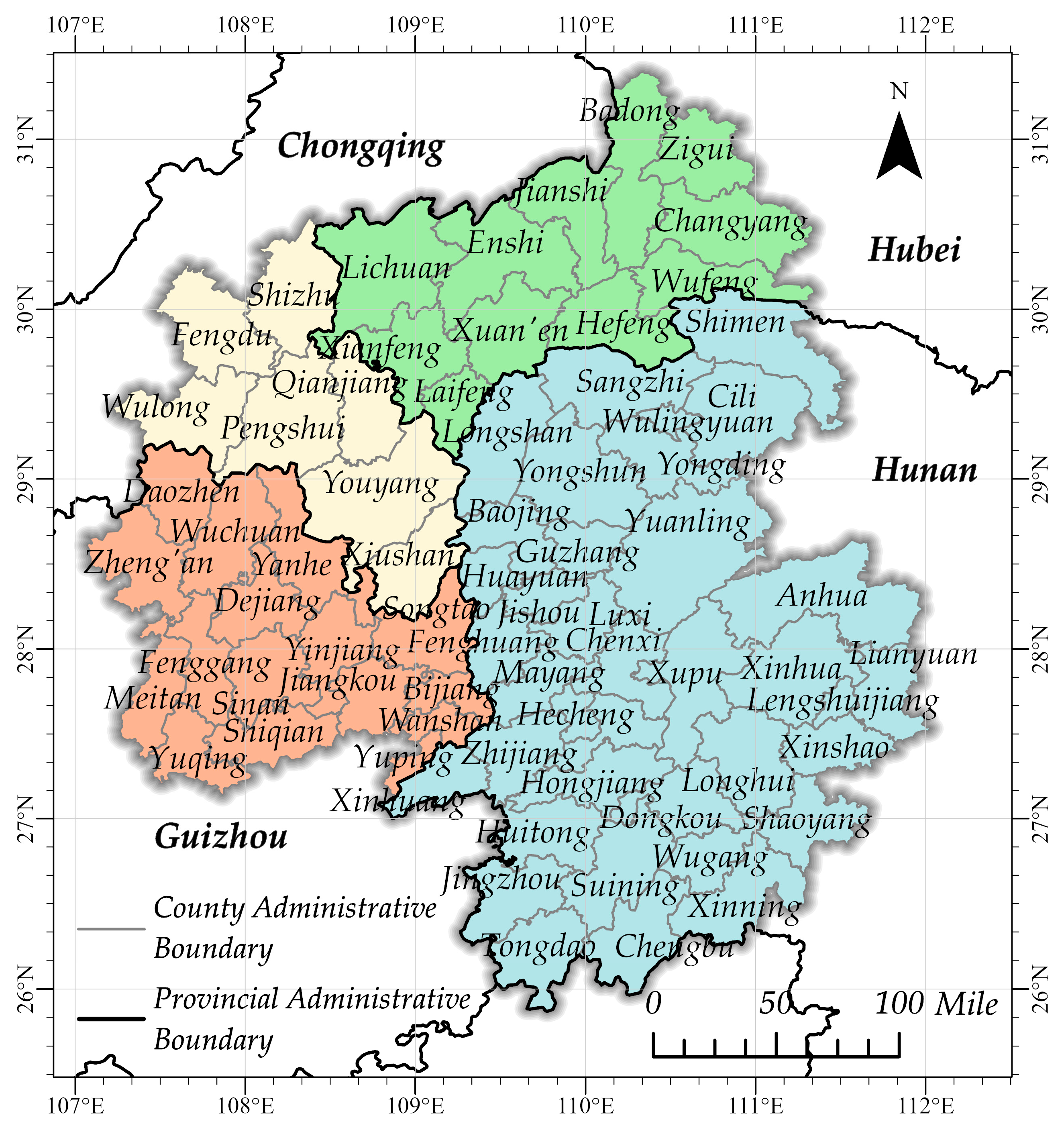


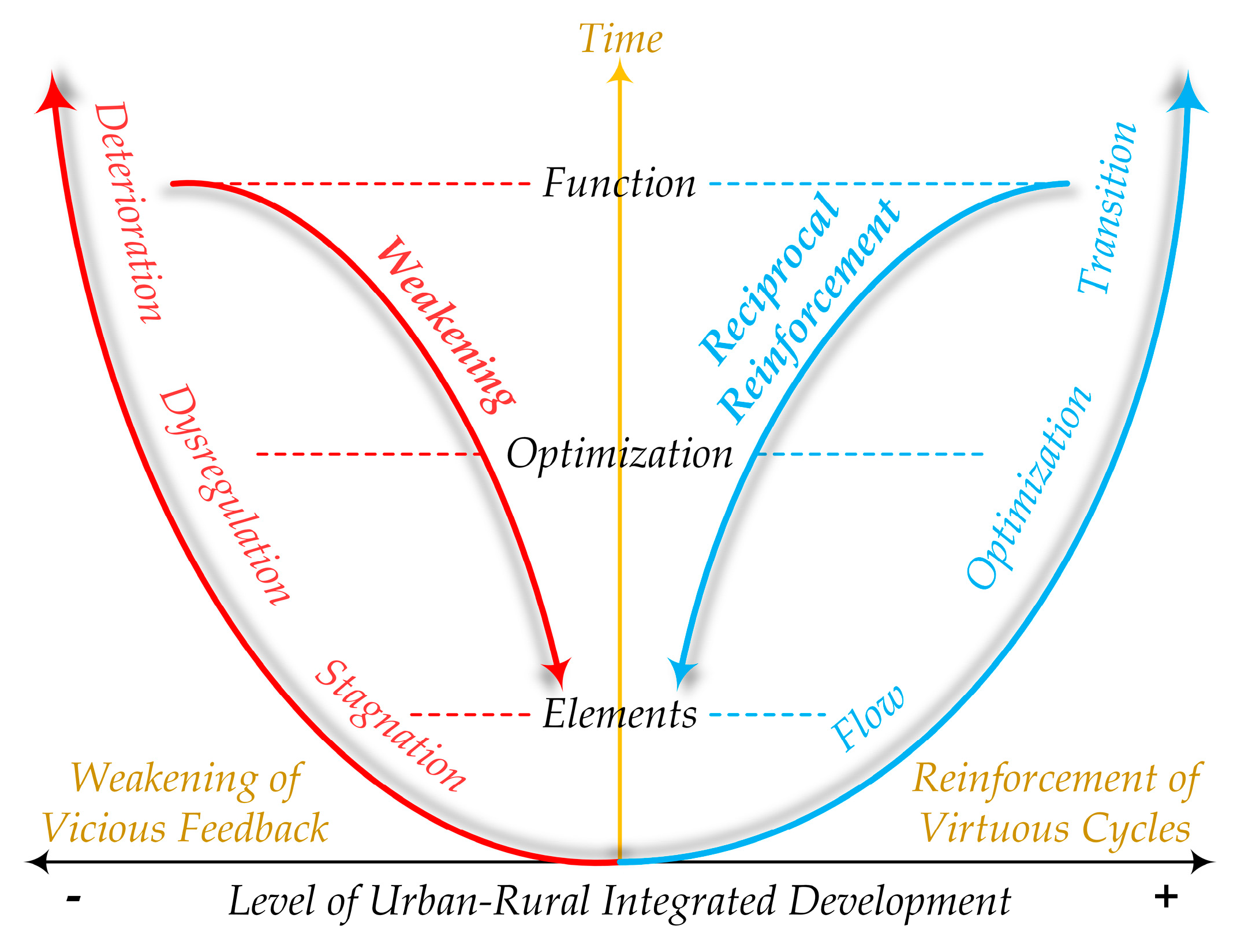

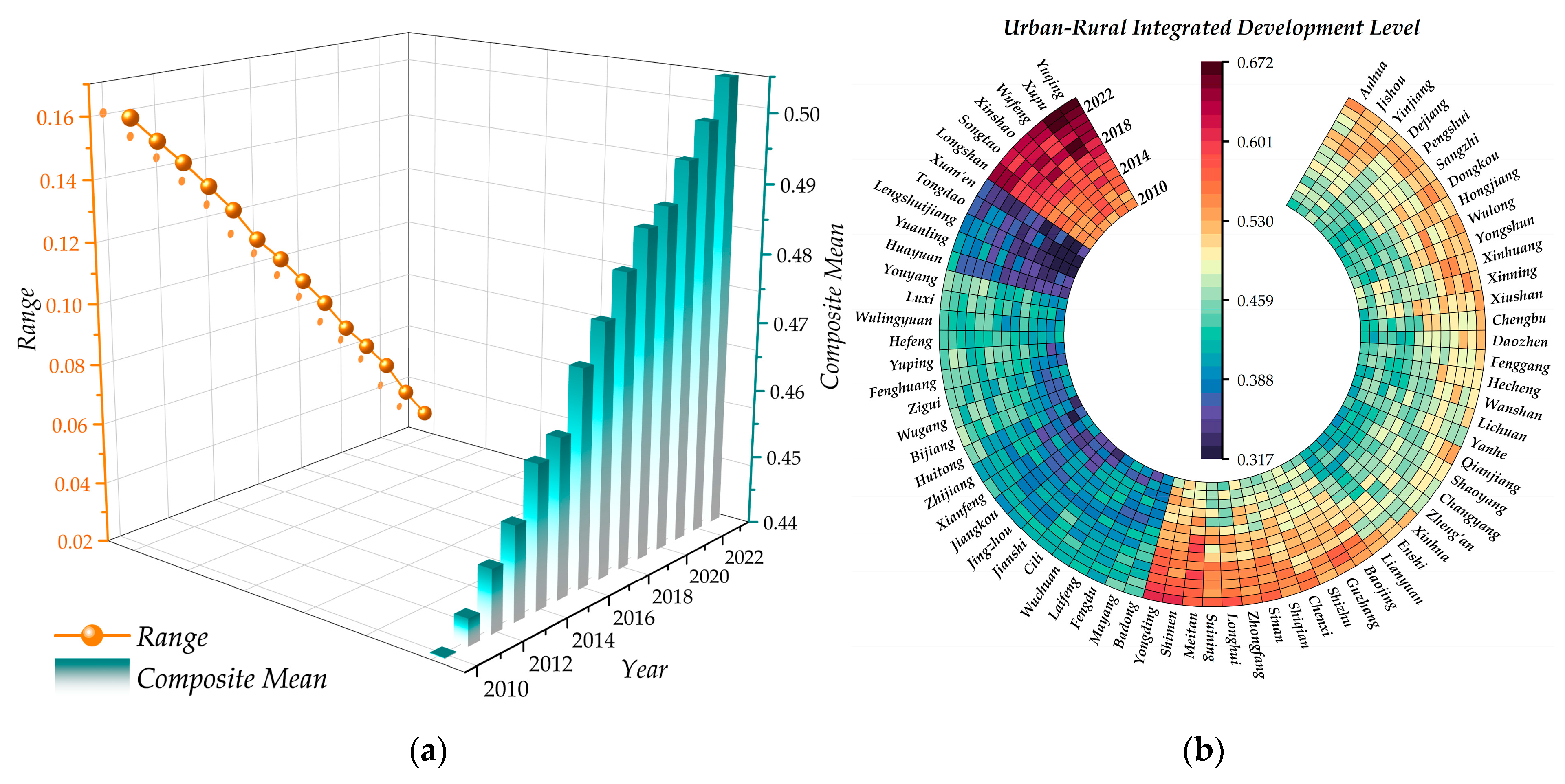
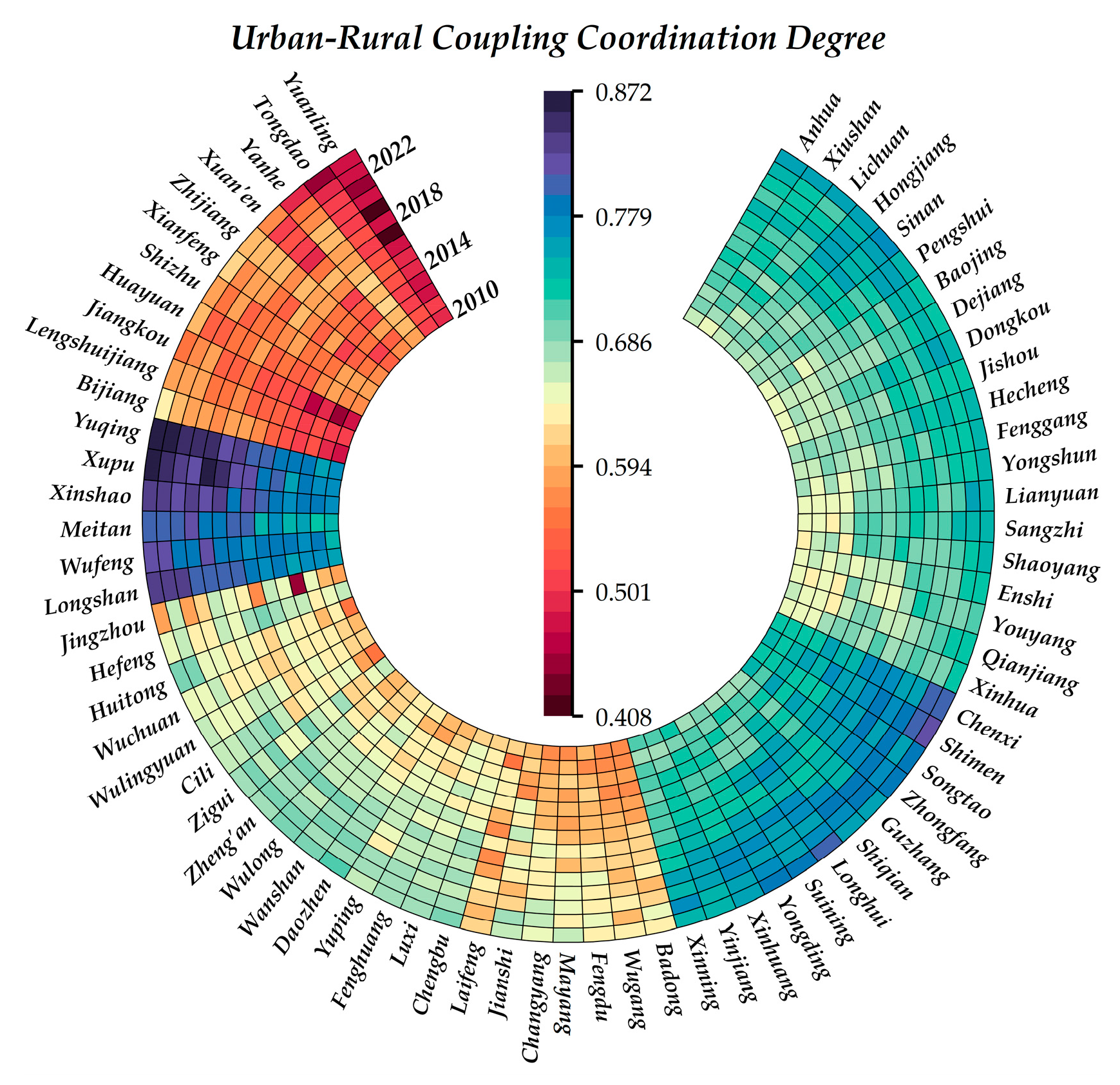

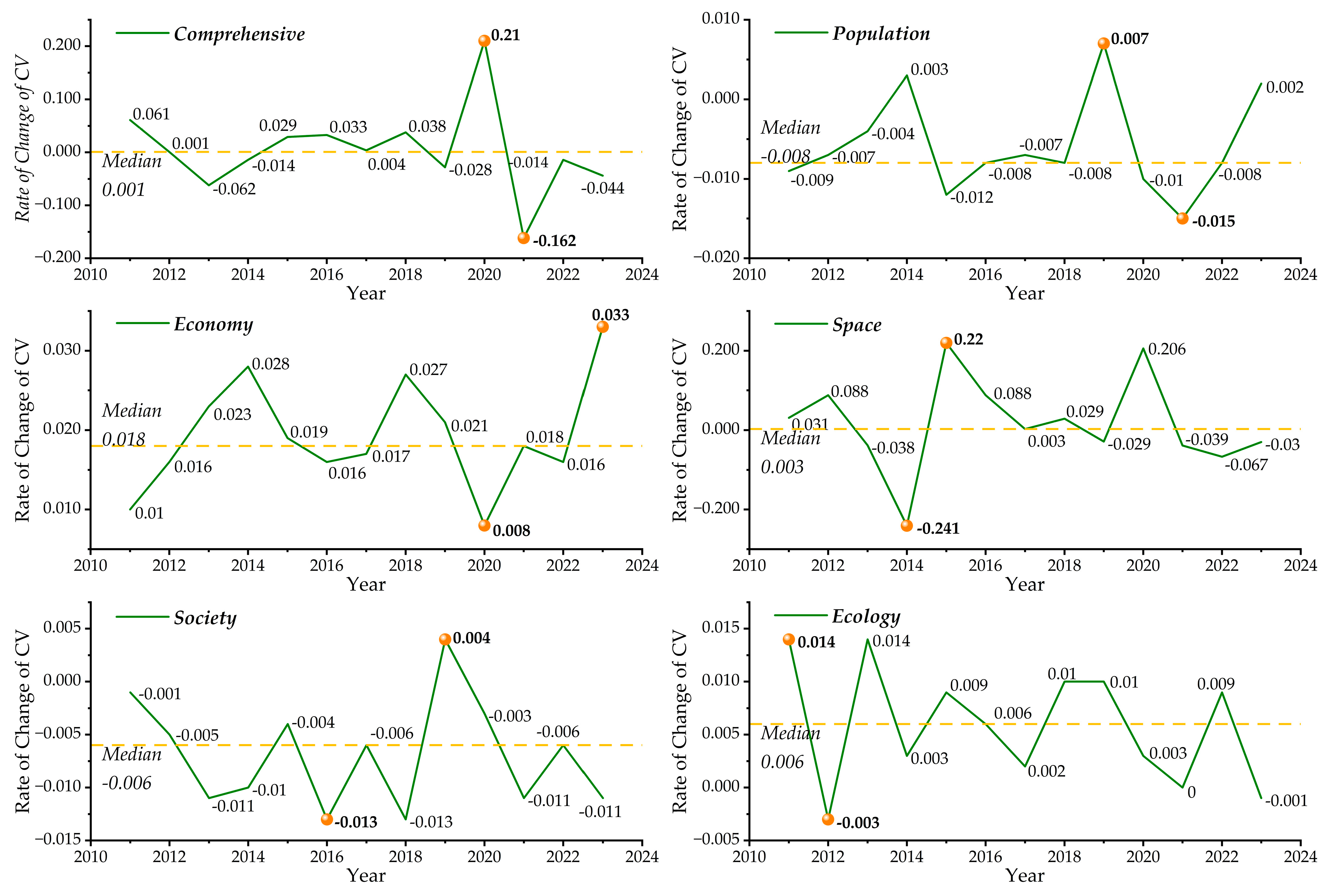
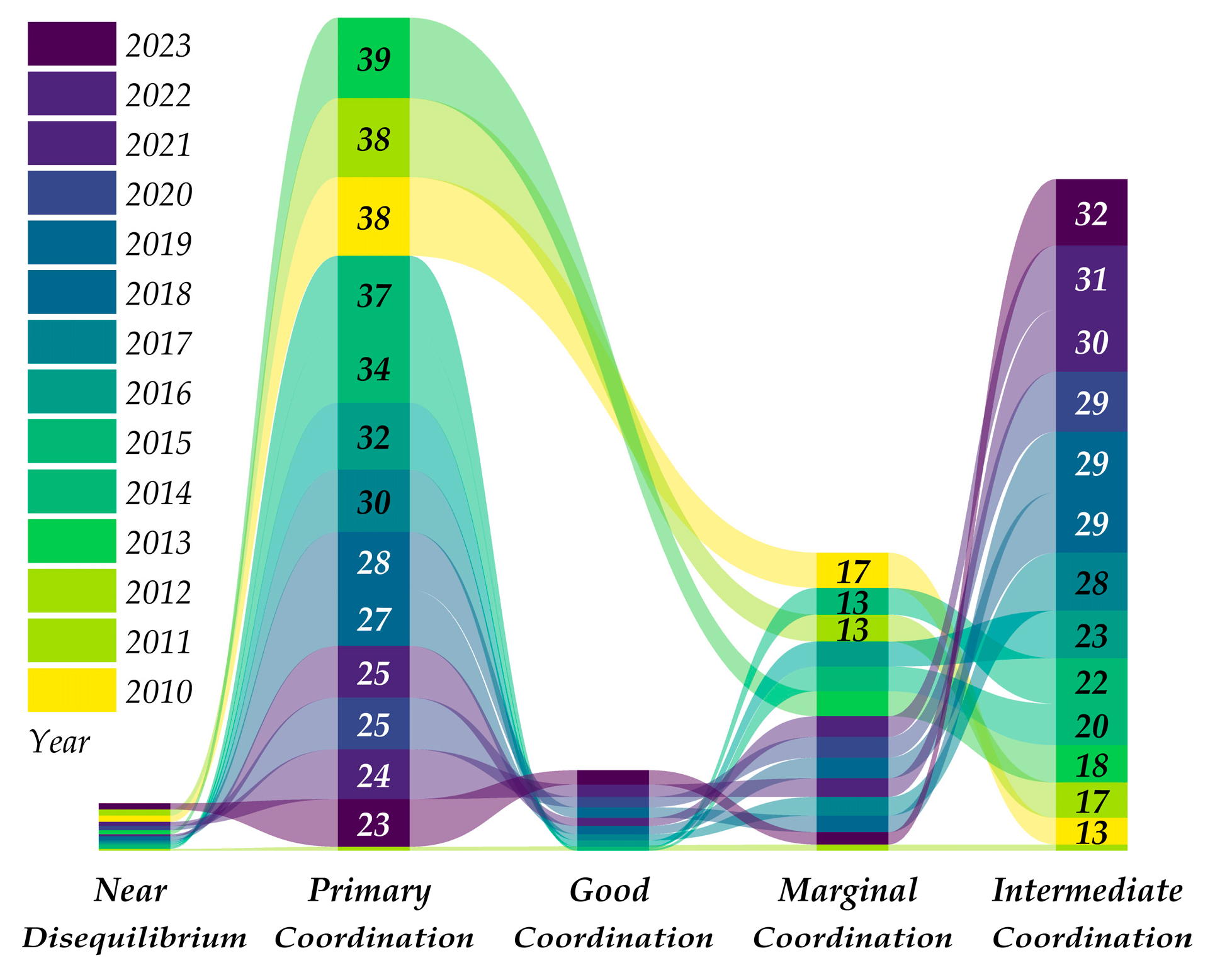
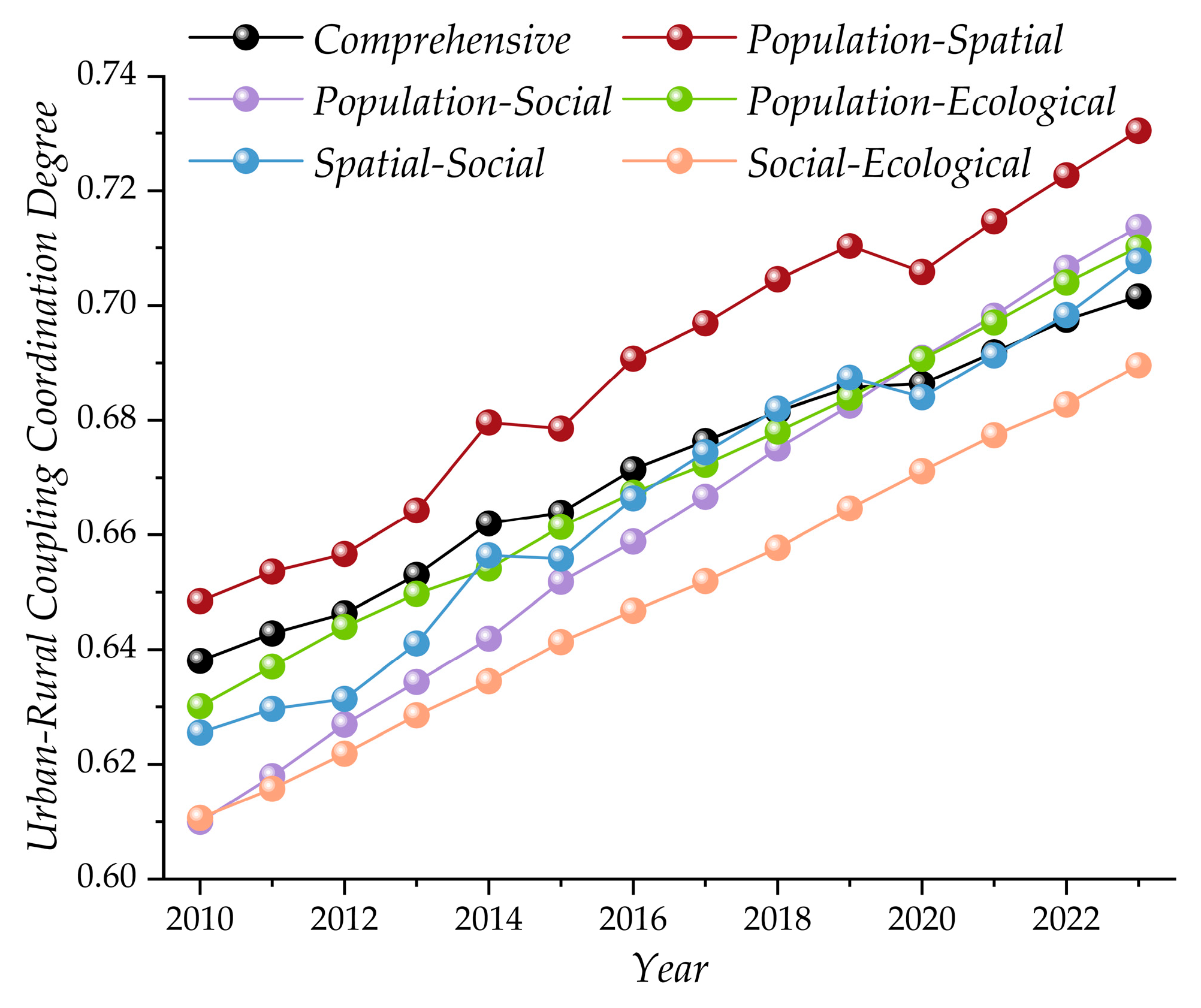
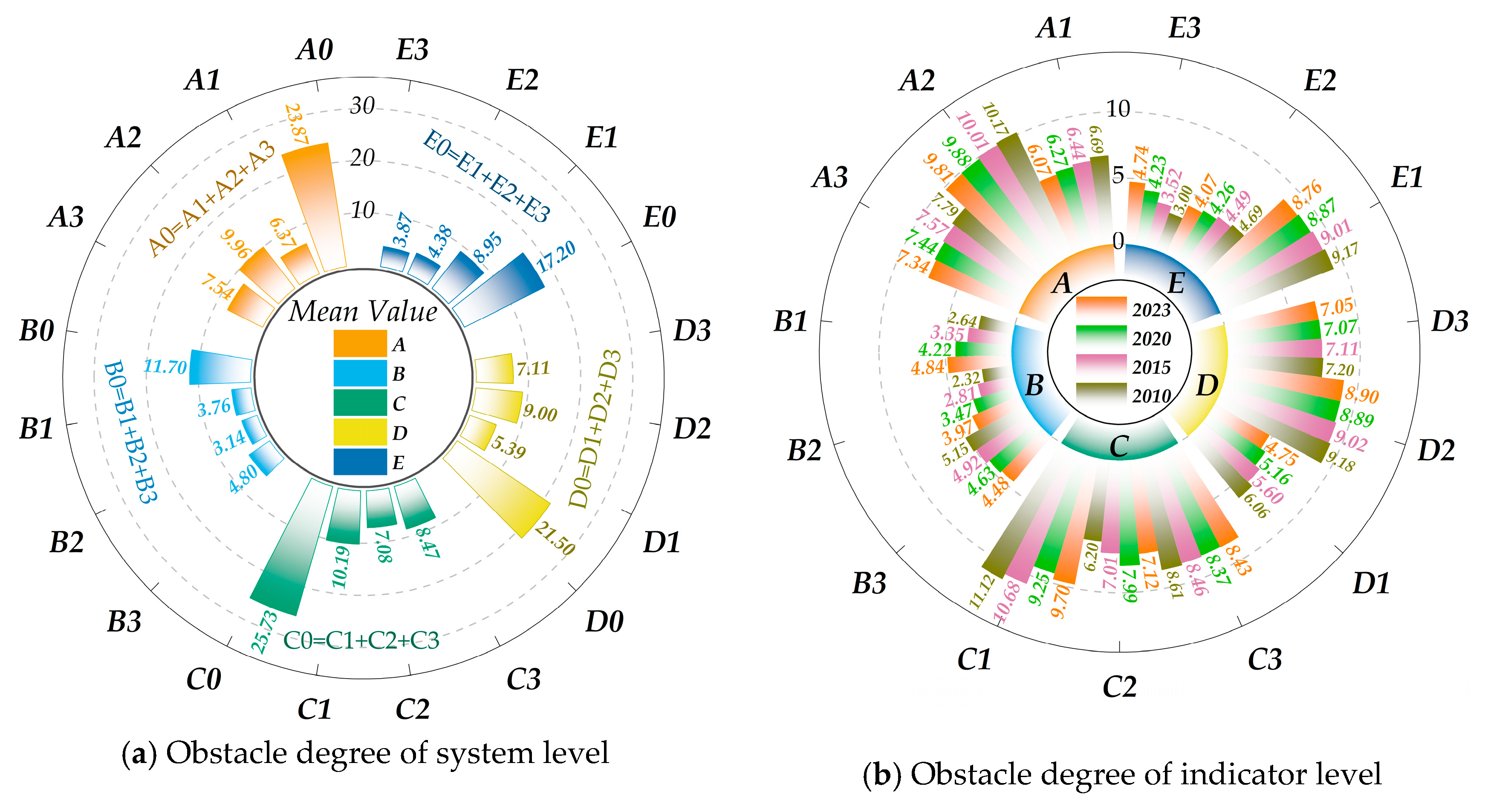
| System Level | Indicator Level | Explanation of Indicators | Attribute | Weight% | Source of the Literature |
|---|---|---|---|---|---|
| Population integration (A) | A1 population urbanization | Urban population/permanent resident population | Positive | 6.16 | [28,29,30,31] |
| A2 urban population density | Urban population/total land area | Positive | 9.00 | [30,31] | |
| A3 non-agricultural employment ratio | Non-agricultural employment/agricultural employment | Positive | 7.06 | [2,30,32] | |
| Economic integration (B) | B1 urban–rural income gap | Ratio of per capita disposable income of urban and rural residents | Negative | 4.08 | [2,11,25,28,29,30,31,32,33,34,35,36] |
| B2 urban–rural consumption gap | Ratio of per capita consumption expenditure of urban and rural residents | Negative | 3.92 | [28,29,30,31,34] | |
| B3 non-agricultural output ratio | Added value of non-agricultural industry/added value of agricultural industry | Positive | 5.67 | [2,11,31,34] | |
| Spatial integration (C) | C1 land urbanization | Built-up area/total land area | Positive | 10.06 | [2,11,25,28,29] |
| C2 transportation network density | Highway mileage/total land area | Positive | 7.36 | [22,32] | |
| C3 urban and rural land allocation | Total sowing area of crops/built-up area | Positive | 8.37 | [2,11,35] | |
| Social integration (D) | D1 medical resource guarantee | Number of beds in the hospital and health center per 10,000 people | Positive | 5.10 | [2,11,28,29,30,31,32,33,34] |
| D2 cultural service supply | Number of public library books per 10,000 people | Positive | 8.56 | [22,32] | |
| D3 educational resource allocation | Number of primary and secondary school students per 10,000 people | Positive | 6.87 | [28,31,32,33] | |
| Ecological integration (E) | E1 green coverage rate | Green area of built-up region/built-up area | Positive | 8.15 | [11,28,35] |
| E2 pollution control efficiency | Harmless treatment rate of household waste | Positive | 4.86 | [22,32] | |
| E3 environmental agriculture production | Fertilizer application rate/total sowing area of crops | Negative | 4.79 | [2,11,35] |
| D-Value Interval | Level Type | Characteristic Definition of Urban–Rural System | D-Value Interval | Level Type | Characteristic Definition of Urban–Rural System |
|---|---|---|---|---|---|
| [0~0.1) | Extremely imbalanced | Weak interaction, and severely imbalanced development | [0.5~0.6) | Barely coordinated | Interacting, but further strengthening needed |
| [0.1~0.2) | Severely imbalanced | Limited connections and significant differences in development | [0.6~0.7) | Primary coordination | Initially benign, and its development tends to be synchronized |
| [0.2~0.3) | Moderately imbalanced | Correlation and overall significant imbalance | [0.7~0.8) | Intermediate coordination | Strong interaction, and the effect significantly improves |
| [0.3~0.4) | Slightly imbalanced | Enhanced interaction, but still uneven development | [0.8~0.9) | Well-coordinated | Stable relationship, and relatively balanced development |
| [0.4~0.5) | Endangered imbalance | Fragile relationship, approaching coordinated development | [0.9~1] | Highly coordinated | Highly integrated, and good mutual feedback effect |
| Stage | Comprehensive | Scale (Population + Economy) | Breadth (Space + Society) | Benefits (Ecology) | |||
|---|---|---|---|---|---|---|---|
| Growth | Growth | Contribution Rate | Growth | Contribution Rate | Growth | Contribution Rate | |
| 2010–2014 | 0.0202 | 0.0116 | 22.92% | 0.0310 | 61.16% | 0.0161 | 15.91% |
| 2014–2018 | 0.0216 | 0.0130 | 24.07% | 0.0329 | 60.93% | 0.0161 | 14.91% |
| 2018–2023 | 0.0229 | 0.0148 | 25.76% | 0.0304 | 53.10% | 0.0242 | 21.14% |
Disclaimer/Publisher’s Note: The statements, opinions and data contained in all publications are solely those of the individual author(s) and contributor(s) and not of MDPI and/or the editor(s). MDPI and/or the editor(s) disclaim responsibility for any injury to people or property resulting from any ideas, methods, instructions or products referred to in the content. |
© 2025 by the authors. Licensee MDPI, Basel, Switzerland. This article is an open access article distributed under the terms and conditions of the Creative Commons Attribution (CC BY) license (https://creativecommons.org/licenses/by/4.0/).
Share and Cite
Chen, J.; Yang, J.; Lu, D.; Wang, F.; Yang, D.; He, T. Evaluation, Coordination Relationship, and Obstacle Factor Analysis of Integrated Urban–Rural Development in Counties of Wuling Mountain Area. Sustainability 2025, 17, 10010. https://doi.org/10.3390/su172210010
Chen J, Yang J, Lu D, Wang F, Yang D, He T. Evaluation, Coordination Relationship, and Obstacle Factor Analysis of Integrated Urban–Rural Development in Counties of Wuling Mountain Area. Sustainability. 2025; 17(22):10010. https://doi.org/10.3390/su172210010
Chicago/Turabian StyleChen, Jiaheng, Jian Yang, Debin Lu, Feifeng Wang, Dongyang Yang, and Tingting He. 2025. "Evaluation, Coordination Relationship, and Obstacle Factor Analysis of Integrated Urban–Rural Development in Counties of Wuling Mountain Area" Sustainability 17, no. 22: 10010. https://doi.org/10.3390/su172210010
APA StyleChen, J., Yang, J., Lu, D., Wang, F., Yang, D., & He, T. (2025). Evaluation, Coordination Relationship, and Obstacle Factor Analysis of Integrated Urban–Rural Development in Counties of Wuling Mountain Area. Sustainability, 17(22), 10010. https://doi.org/10.3390/su172210010








